The Lost Riviera: Montenegro Is on the Cusp of Discovery (and EU Membership)
23 min readThe Aegean Airlines turboprop banked hard on final approach into Podgorica, Montenegro. Outside the window, I watched the ghost of Ansel Adams have a moment…
Early evening had swallowed the valley below, the landscape muted in a pale gray.
There in the distance, in the V formed by the jagged Kučka Krajina mountains, the day’s final rays swept across a sheer rock face. The entire scene looked stolen—as though the Montenegrin government had plagiarized Ansel’s “Thunderstorm, Yosemite Valley” to impress arriving tourists.
Last time I was here—December 2020—I was marrying a woman from Crimea, Yulia. Amid the global pandemic, Montenegro was one of the only two countries in Europe she and I could both easily access. And so we got hitched here, in Budva, on a cliff overlooking the Adriatic Sea on a gray and drizzly morning.
I sensed, back in 2020, that something big was coming to Montenegro: recognition. Not just from tourists, but from discerning travelers and increasing numbers of people seeking a life overseas, either for retirement or as digital nomads. Montenegro back then was clearly positioning itself as the new it destination for tourism and for the growing business of residency-by-investment.
I returned because I wanted to know how my four-year-old prediction turned out.
Spoiler alert: I was right.
Sign up for our free daily IL Postcards e-letter and we’ll immediately send you a free report on the WORLD’S #1 RETIREMENT HAVEN—plus 9 more of the most desirable and very affordable destinations where you can upgrade your retirement right now. Each day you’ll learn about the best places to retire, travel, buy real estate and enjoy life overseas.
By submitting your email address, you will receive a free subscription to IL Postcards and special offers from International Living and our affiliates. You can unsubscribe at any time, and we encourage you to read more about our Privacy Policy.
Croatia and Portugal—once Europe’s it destinations—are already tired. Portugal is now actively dissuading digital nomads from relocating there, despite having just launched the D8 digital nomad visa in late 2022.
But Montenegro—particularly Kotor Bay—is beginning to wave its hand to attract the travel and residency world. It’s emerging as the next must-see spot for the vanguard of travelers who test-drive a country before the Starbucks warriors arrive en masse.
And it’s emerging as a fantastic option for those who want to live in Europe affordably, or who want to own property in Europe before mass travel sends property prices spiking higher.
“The growth has been crazy over the last four or five years,” Katarina told me. She’s Kotor Bay born and bred, a preternaturally pretty blonde at the Nikki Beach Hotel, situated along what might just be the single-most picturesque and quiet stretch of Kotor Bay.
My description of Katrina isn’t a “male gaze” kind of thing. The entire Nikki Beach staff—men and women—are unnaturally beautiful, reflective of Montenegro as a whole, I’ve come to learn. Shopkeepers, rental-car office workers, waitstaff, receptionists, police officers directing traffic, airport check-in staff, the cashiers at gas stations and supermarkets—the entire collection of Montenegrins, it seems, are spilled from an issue of Vogue.
The growth Katarina mentions is not hard to suss out. New roads and highways are under construction, befouling traffic here and there. New hotels and apartments are popping up all over the towns of Kotor and Tivat, many of them fashioned elegantly from limestone blocks that, against the backdrop of calm waters and mountains, leaves Kotor Bay feeling like a misplaced piece of Italy’s Lake Como. New—albeit undersized—malls and shopping centers have emerged in places I remember as empty fields.
Entire new towns are growing up too, like Luštica Bay, a planned community of shops, eateries, hotels, homes, and a Lilliputian marina pressed hard against the Adriatic.
Looking at it and knowing nothing about it, you could easily assume Disney is attempting to recreate a waterfront village from the Venetian Empire.
In short: Montenegro is the new Croatia—only, not many people have realized that just yet, given that Croatia annually pulls in nearly 10 times the number of tourists as visit neighboring Montenegro. (Dubrovnik alone sees more than a million tourists annually, roughly half the number that the whole of Montenegro records.)
Not only is this a gorgeous part of the world to vacation, but the rapidly expanding infrastructure tells me that Kotor Bay coastal and bayfront real estate will rise sharply in value in the coming years.
I’m betting increasing numbers of American retirees will give Montenegro a look, too, because the cost of living is so low, the scenery is so epic, the lifestyle is so relaxing, and the requirements for residency are so minimal (the equivalent of just $4,000 in a Montenegrin bank, or provable income of about $380 per month, plus proof of housing). And after five years, you can apply for permanent residency…
Dragons, Plagues, and Ice-Cold Beer
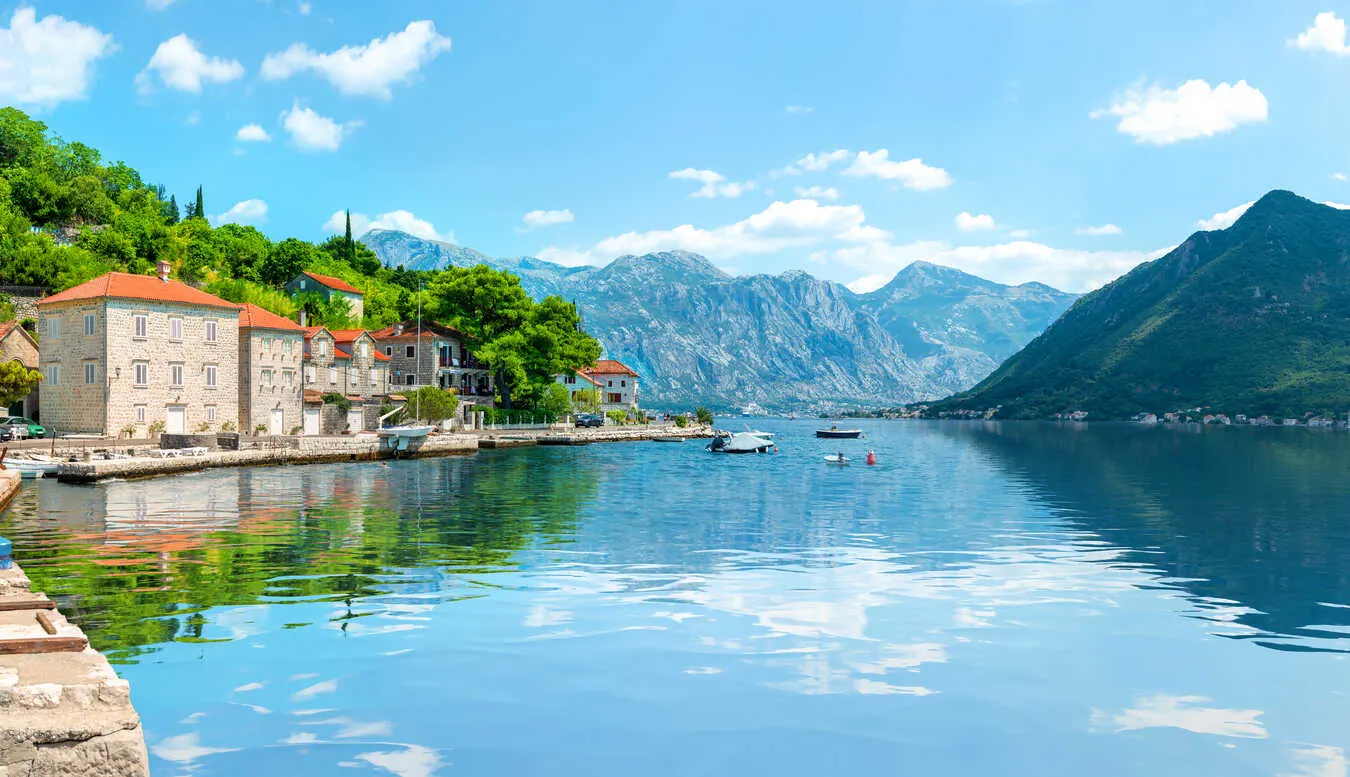
Experience Montenegro’s rich history and vibrant local life in Kotor Bay.|©iStock/Givaga
I started my four-day Kotor Bay adventure at Nikki Beach Hotel, having driven about two hours from Podgorica’s sparrow-sized international airport on what would turn into a windy and rainy night.
Roads in this part of Kotor Bay are manly, if roads can be described as such. Street lights? Don’t need no stinkin’ street lights. Nor smooth pavement. Nor roads wide enough for two cars to pass. Suck it up, buttercup, and welcome to Montenegro! If it was good enough for the Romans, Byzantines, Venetians, Ottomans, and Hungarians, who all used these same paths in building and supplying their empires over the millennia, then it’s good enough for you today.
The next morning, I woke early to birdsong and pulled open the drapes in my hotel room to find low-hanging, sweatshirt-gray cottony clouds speckling a cobalt sky and hiding the peaks of some of the most jagged mountains I’ve seen outside of Montana’s Sawtooth Range. I’m convinced dragons live here. (Turns out, local legend claims a dragon does hide in a mountainous lake north of Podgorica, so I feel confident his relatives are here in Kotor Bay.)
The hotel restaurant sits on a covered patio just at the bay’s edge, looking out over the water and the mountains. A cruise ship in the distance, making for the town of Kotor, could have been a small toy in a bathtub, its scale miniscule relative to the landscape’s grandeur.
Moments later, I made for Kotor myself. First mentioned by Romans in 168 BC—though dating back to the Illyrians 500 years earlier—Kotor is the primary hive of activity in the bay region. My goal was Old Town, where in 535 Emperor Justinian built a mountain fortress to fend off Germanic Ostrogoths eager to plunder a Rome in decline.
Today, Old Town is a warren of ancient stone homes, Airbnbs, boutique hotels, shops, and restaurants tucked into narrow alleys and open plazas, all walled in by a ring of thick, gray stone ramparts erected in the 9th century to keep out the invaders and rabble-rousers that came a-calling over the years.
Uniquely, the almost three-mile-long wall doesn’t just ring an Old Town that’s small by European standards. It runs up, down, and around a steep mountain that serves as Old Town’s towering backbone, just in case aggressive invaders thought attacking from above would be a sneaky and unexpected approach.
My wife and I had Old Town to ourselves back in December 2020, a time of year when much of the region is buttoned up for winter holidays (pandemic aside). We found an entrance to a walkway that snaked up the side of the mountain to a chapel built in 1518— the Church of Our Lady of Remedy. A tiny little stone structure perched about 650 steps up the mountain that looms like Lord of the Rings’ Mordor over the orange-tiled roofs of Old Town below. (Seriously, there must be dragons here.)
“Romans, Byzantines, and Venetians all traveled these paths.”
On that trek, she and I might have passed one or two other souls. But this time around—mid-May, 2024—I passed scores of folks of all ages making the pilgrimage. And I had to shell out €15, whereas last time the gate was open to anyone who wanted their winter exercise.
Resting on the steps of the church 30 minutes later, I eavesdropped on a woman leading a British tour group. Apparently, Kotor was ravaged by various bouts of plague in the Middle Ages, and the faithful— and desperate—would crawl on hands and knees up the snaking cobble-stone and gravel path to the chapel in the belief that doing so would protect them from Black Death. Or so the stories claim.
Back in the central square, I collapsed into a chair under an umbrella at one of the many cafés. The waiter, Dmitri, clearly knew the signs of touristica exhaustidus and dropped off a small Nikšicko lager, gratis, with a smile.
“How high did you go?” he asked.
“The little church.”
“Halfway. Couldn’t make the full trip?”
A snarky waiter with a grin.
The “full trip,” I’ll note, is another 700 steps or so up to St. John’s Fortress and a stellar view out over the region. But no—I couldn’t make it. I’d forgotten to pack water, and another 30 minutes higher, then an hour back down the same steep and cragged path, seemed unnecessarily torturous. Better to just claim protection against future bouts of Black Death and go in search of a very cold beer below.
So, I ordered the grilled mackerel from Dmitri and pulled out my phone to plot my drive to the teensy village of Perast, 20 minutes further on.
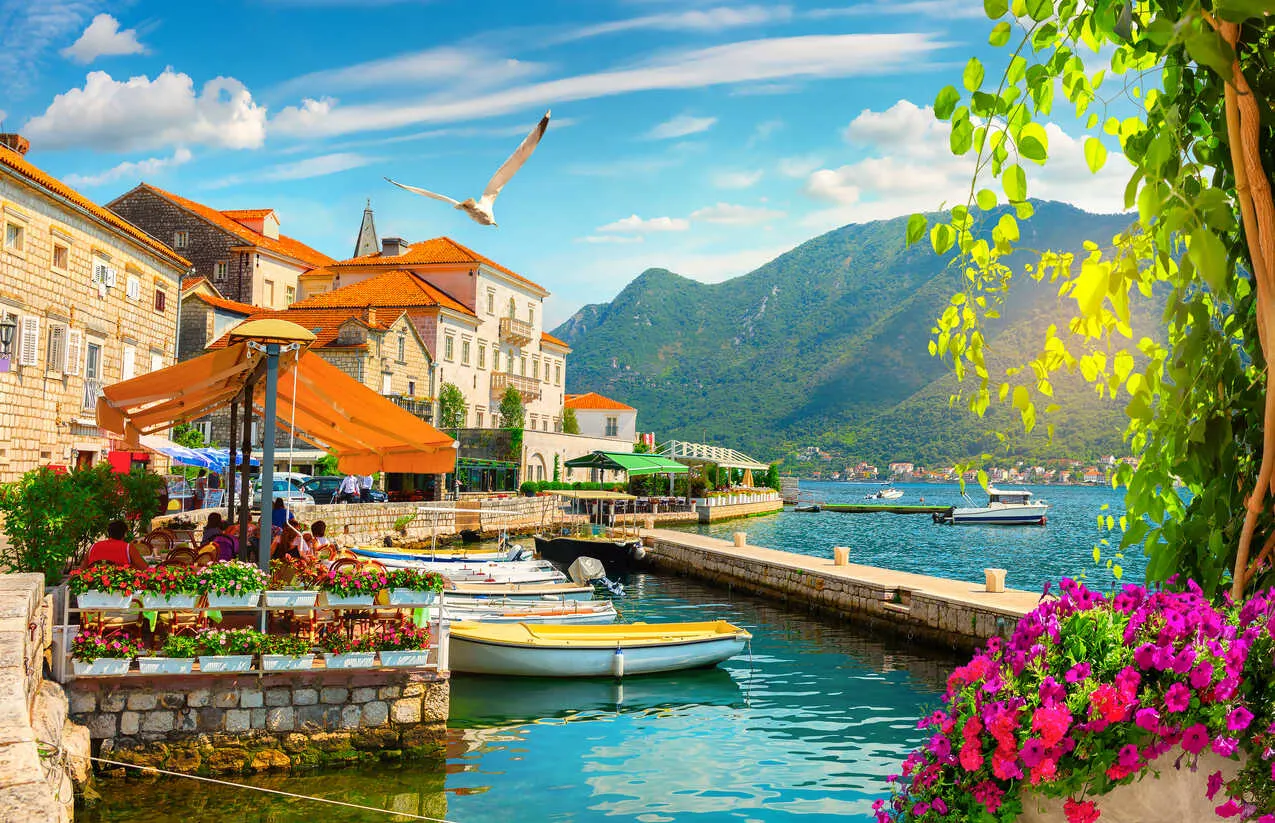
Perast, Montenegro: A tranquil town reminiscent of Lake Como’s beauty.|©iStock/Givaga
“Plotted” is a word way grander than needed in this instance. There is but a single road ringing the entire bay. That is one’s sole motoring option.
But what a road.
Winding around the bay at water level. Passing oyster farms and fish farms. The mountains pressing in on you from one side, the bay hemming you in on the other. Every turn seems to deliver its own special-order Kodak moment. So many times I wanted to pull over and snap a picture or film a quick video. So many times I couldn’t because there was no place to stop.
Quick aside: Rent a car when in Kotor Bay. Do not disregard this suggestion. Driving this part of the world is a visual fiesta, and stopping wherever you do find a pull-out or a parking lot—to take a picture or relax on a concrete pier, with your feet dangling into the bay—is almost assuredly the reason Karl Benz built the first car.
Turns out, this is the same road ancient Romans trod in their trade through this region thousands of years ago, so you are literally driving the footsteps and donkey-cart paths of history.
Perast is Lake Como in miniature. Italianate houses with the bay lapping at their foundation. Byzantine, Baroque, and Renaissance churches peeking out from behind, their bells tolling every now and again. The classic wooden speed boats—runabouts—docked here and there or motoring off on two-minute rides to the teensiest of islands for visits to the Church of Our Lady of škrpjela. Al fresco dining literally at water’s edge. Mountains and bay in every direction.
Stopping for a cooling beverage at one of the bayside cafés, I bumped into Paul and Brenda, a couple from Sacramento who’d been in Montenegro for two weeks.
“A European friend told us to come,” Paul told me. “I don’t think we’d ever heard of Montenegro.” He looked at his wife; she shook her head. “I don’t know what I was expecting, but it wasn’t this. I’ve taken, I bet, a thousand pictures on my phone, but I still don’t think any of them are going to really show our friends how gorgeous this place is.
“A Montenegrin passport would be a free pass into the EU.”
“You have to see it… see the mountains and the bay and the towns in relation to one another to really understand the scale of how pretty it all is.”
The missus nodded her head this time, and I nodded mine.
Just arrive early in Perast if you’re here in spring and especially summer. Tour buses and regional buses from nearby towns trundle to a stop regularly, and the place can feel like a theme park as you navigate the hordes.
Better yet, arrive off-season, mid-September, when late-summer warmth still swaddles the bay but the tourists are all back to their normal lives in Britain, Germany, and France. You’ll have the town pretty much to yourself.
Personal aside: Perast would be a fantastic place to live, so long as one is good with a very quiet off-season. There’s not a prettier place in the whole of Kotor Bay. Kotor proper sits just down the bay to the left; on their way in and out of Kotor, cruise ships navigate a narrow gap in the mountains just in front of Perast. Truly gorgeous scenery.
Sign up for our free daily IL Postcards e-letter and we’ll immediately send you a free report on the WORLD’S #1 RETIREMENT HAVEN—plus 9 more of the most desirable and very affordable destinations where you can upgrade your retirement right now. Each day you’ll learn about the best places to retire, travel, buy real estate and enjoy life overseas.
By submitting your email address, you will receive a free subscription to IL Postcards and special offers from International Living and our affiliates. You can unsubscribe at any time, and we encourage you to read more about our Privacy Policy.
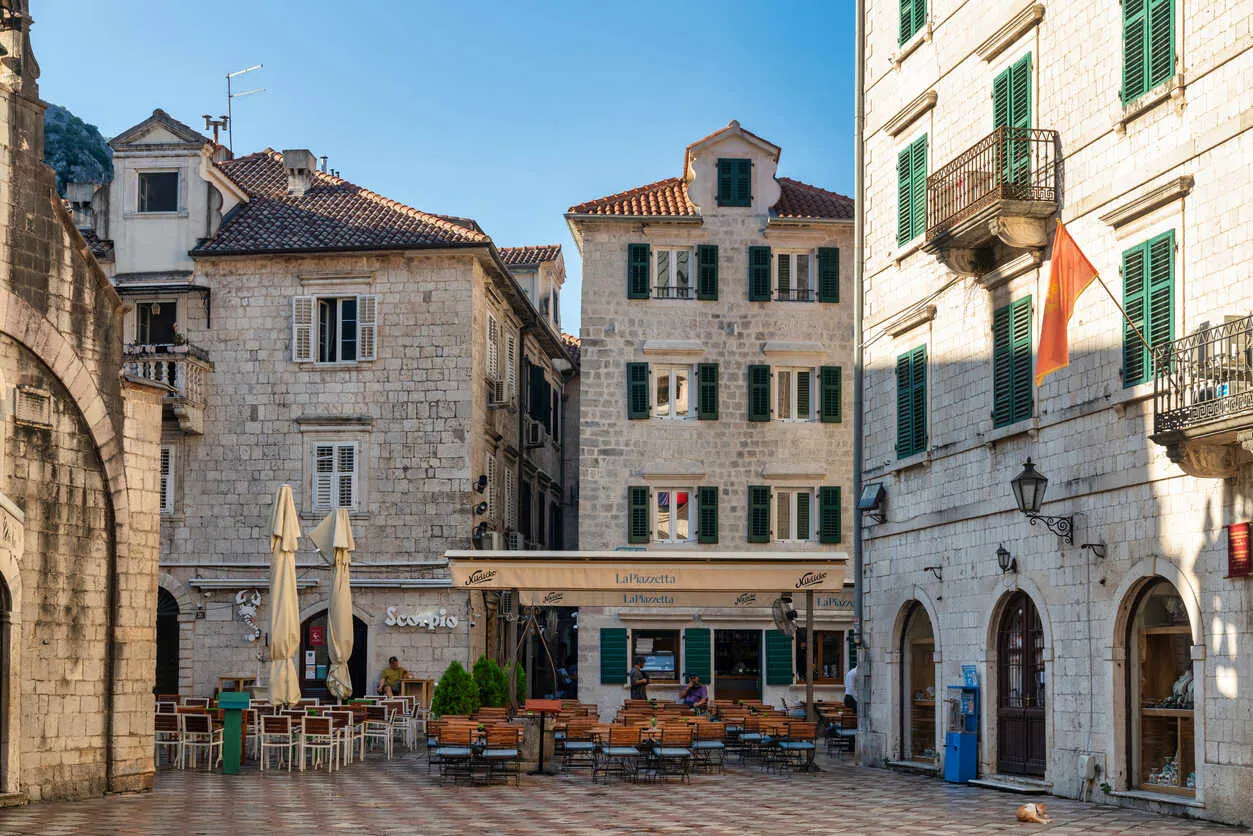
Montenegro’s path to EU membership opens new doors for expats and investors.|©iStock/Starcevic
One of the reasons I’d come to Kotor Bay was to see the towns springing up that are geared toward foreigners—especially those with money to spend and who might be looking for easy access into Europe by way of a Montenegrin residence permit and, potentially, a local passport one day.
The country is on the path to European Union inclusion, and a Montenegrin passport would instantly become a free pass into the EU. So, wealthy Russians, Ukrainians, Chinese, and others have been eagerly dropping wads of cash here to grab a house and a passport.
At least, the country is on the path to EU inclusion. But it’s a years-long process. “I don’t think EU ever happens.
I hope it doesn’t.” That was Ilija, a bus driver—local stops only, not tours. I struck up a conversation with him in a parking lot while we waited for an evening traffic jam to subside. “No EU means freedom to take everyone Europe doesn’t like. Keeps us neutral. More opportunity. More money.”
Ilija’s not likely to get his wish. Montenegro’s prime minister is eagerly pushing for EU accession by 2028, a sense of urgency bolstered by Russian antics in nearby Ukraine. Moreover, the country already uses the euro as its currency, so accession into the EU seems a foregone conclusion.
That said, the option for a Golden Visa, or buying real estate to land a local passport, is no longer available because politicos in Podgorica realized that the passports they were selling with each property were attracting nationalities Europe has a problem with, and Montenegro clearly doesn’t want to quash its own EU dreams.
However, you can still obtain residency by buying real estate of any value; just make sure it’s a property and not raw land (or if you buy raw land, then quickly build a house to gain a residence permit).
Many buyers are showing up these days to grab turn-key apartments and condos for €250,000 and up, then turning them into Airbnbs. Places like Luštica Bay, Portonovi, and Porto Montenegro, in particular, are popular options on that front.
They’re lovely marina enclaves attracting lots of foreigners looking to own local real estate before the region soars in popularity. Porto Montenegro in Tivat—formerly a deep-water naval base for submarine repair—has even attracted the Saudi royal family’s Golden Fleet of yachts that will now call the marina home for the next 30 years. That fleet had previously anchored in Nice, on the French Riviera, so that gives you a hint of the status Porto Montenegro is chasing.
I spent two nights in an Airbnb in one of the residential buildings in Porto Montenegro. The apartment was nice; well appointed with everything you need—from kitchen to air conditioner to private pool access. And the surroundings were certainly pleasant: the yacht harbor, nice restaurants, banks, a hipster coffee shop, even a downsized version of a local supermarket chain. Perfect for tourists who want Western conveniences and tourist-style food options, or for residency migrants who want to rent or own a modern, Western-style apartment in a setting that feels like it could be in Miami or Seattle.
As a traveler, I want authenticity. Which is why these Disney-like, newly built marina towns are not for me, personally. Porto Montenegro feels like a resort destination devoid of anything that says, “This is Montenegro—we do things differently here.”
That said, dinner at a Porto Montenegro restaurant called Marea—veal with stuffed potatoes—was superb and, at €25, reasonably affordable for the location, though about 70% more than equally nice eateries in Tivat just outside the gates of Porto Montenegro.
But the ambiance—those ever-present mountains, the bay, an indigo sunset and the silhouettes of mega-yachts, their crews lounging on the boats and laughing—well, I can’t quibble with any of that.
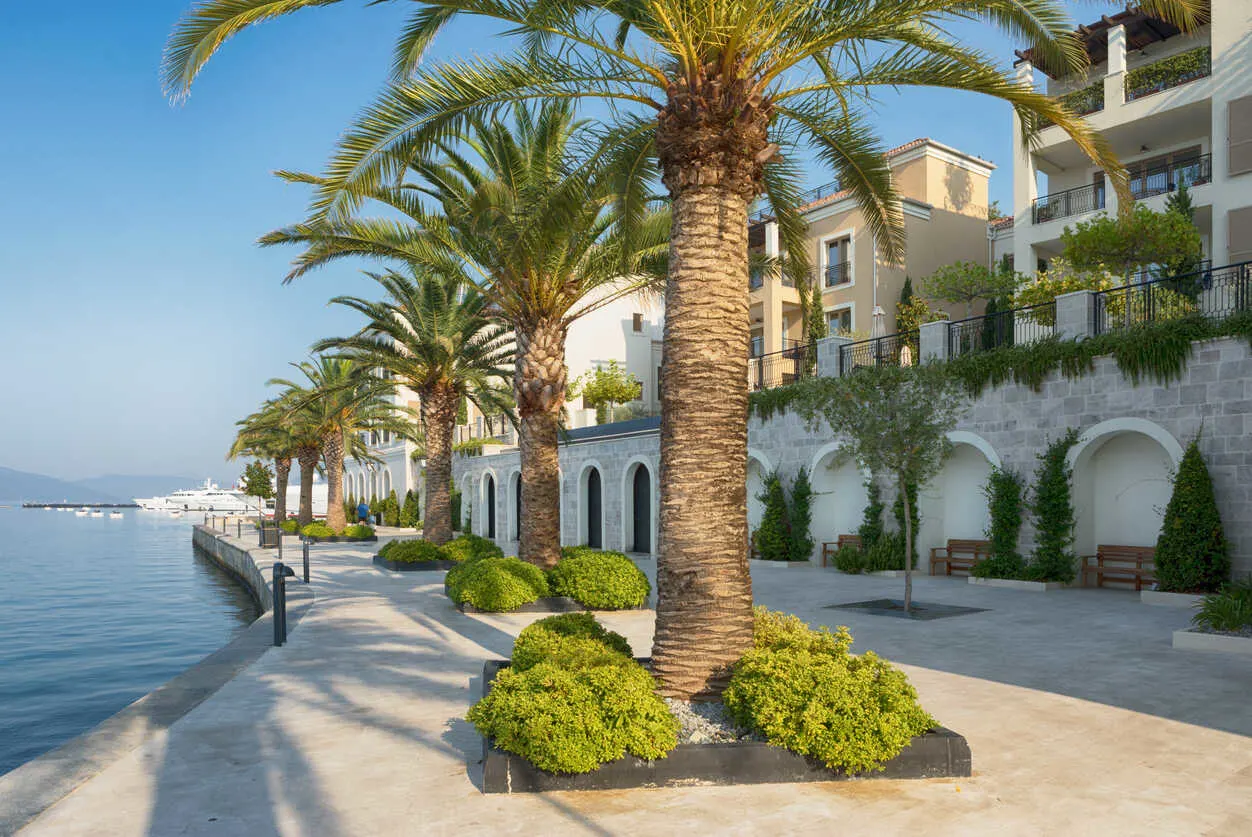
Explore Montenegro’s authentic charm, from ancient churches to local towns.|©iStock/tunart
I left Tivat one morning heading north on a route that would have taken me to Kotor along the backroads, meaning along the coastal road (more on that driving adventure in a moment).
About five minutes outside of town, the road north splits—one lane heading on to Kotor, the other pulling into a miniature parking lot where one hops out of the car to buy a ticket from a toll-taker in order to drive onto a tiny, low-slung orange-and-white ferry that might hold 20 cars at most.
The Lepetane-Kamenari ferry, as it’s known, traverses Verige Strait, the bay’s narrowest passage—less than 1,000 feet from one side to the other. It’s a 10-minute crossing versus a one-hour drive along ever-winding curves.
I arrived in Portonovi amid sprinkles and sun-showers to find a beautiful ghost town.
People popped up here and there, a game of pedestrian Whack-a-Mole, but most were local employees like groundskeepers, waiters, and security guards. Granted, I was here in May, weeks before high season commences, and it was just 10 a.m., so those were certainly factors. But even at that, Portonovi felt strangely underpopulated.
I took a tour of Portonovi’s high-dollar apartments, including a penthouse listed for more than half a million euro. The place is unquestionably nice. The pretty trappings of Montenegro’s strongly Venetian architecture and landscape. A small marina. Several hip eateries. The penthouse, spread across two floors and more than 3,000 square feet, offered picturesque views out over the mountainous bay from every room and bath. An expensive interpretation of what someone thinks the wealthy want in a Montenegrin pied-à-terre. And maybe they do want that… I’m not sure.
What I am sure of is that the greatest drive I’ve ever undertaken is that backroad from Kotor to Tivat…
I’d spent a morning driving north past Perast to the village of Risan, at an indention near the top of the bay before it turns south. I’d randomly stopped at a small dock to snap a picture and shoot a little video, and I happened to notice an old church hiding behind a leafy park.
Now, I’m not especially drawn to faith, but I do love wandering through old churches, chapels, cathedrals, mosques, and temples—very often beautiful places—where the faithful exercise their beliefs.
This one—the Church of Sts. Peter and Paul—rose up in 1601 and exists in a glorious state of disrepair. Stucco peeling from the walls, ceiling, and columns, and Orthodox saints hand-painted onto a wooden partition near the back of the church.
Not much else to see or do in Risan, but spending time in the church, and strolling the miniscule cemetery up a flight of steps out back, was worth the stop.
“Mother nature spared no expense decorating this part of the world.”
I’ll also note that a new, luxury resort is going in right on the bay in Risan—almost directly across from the church. London’s white-shoe real estate firm, Savills, has listed the one-bedroom penthouse for just over $500,000, which tells you the kind of money Kotor Bay is now attracting from foreigners who want to own property here.
On the way back to Tivat, the main road to Kotor was absolutely slammed with tour buses and cars.
I pulled into a parking lot and dashed across the street for a bottle of water. Returning to my car, I asked the lot attendant about that backroad to Tivat, which was clearly empty and going against the flow of afternoon rush hour. “Ohhh, don’t do that.” He squinched his eyes and shook his head. “Crazy. Very narrow and lots of turns. Too dangerous.”
I shrugged a bit and told him I’d been driving other parts of the bayside road for the last few days. “Ah, yes. Adventure. Go ahead.”
And so I adventured.
He was not lying.
The road is as nerve-racking as it is indescribably beautiful.
This is Formula 1 driving at speeds slower than that Little Old Lady from Pasadena. You gather no pace on this road as it slithers through quaint and picturesque villages, rudimentary outdoor seafood cafés extending out over the bay. Turns are sharp. Corners of ancient buildings pass outside your window with literally inches to spare. Stretches of road torment you with asphalt—air—a six-foot drop into the bay. Nary a guardrail or shoulder in sight.
You will invariably come upon sections of the road much too narrow for two vehicles to pass. Honestly, some of these stretches look too narrow for one car to pass. You spend a good deal of time backing out of untenable situations—or pulling uncomfortably close to the water’s edge—so that approaching vehicles can inch past at the slowest of speeds.
Though it’s only 10 miles in length, the drive can take 45 minutes or longer to navigate.
Greatest. Drive. Ever.
My last morning, on my way out of town, I slipped into a local pekara for a burek, a fried pastry with a meaty-cheesy filling.
The road is under heavy remodel as it passes Tivat’s small international airport serving places like Istanbul, Riga, Belgrade, and Helsinki—spycraft-sounding cities from one or another James Bond movie. Clearly, Tivat leaders are expecting larger tourist hordes soon.
Waiting in line for my burek I heard a British couple who looked to be in their 40s talking about their time in Kotor Bay.
“I do think I could live here, actually,” the wife said.
“Traffic sucks,” the husband offered.
“Temporary,” she shot back. “And we’d have such an affordable life. Imagine the house we can afford here.”
I told my wife the same thing: I would happily live here.
Probably in Kotor, in one of the neighborhoods of old stone houses I drove past on the way to Perast and Risan. Draped in bougainvillea; overlooking the mountainous bay. The definition of lovely.
Having traveled to 80-ish countries now, I have a running list in my head of “best this” and “best that” globally. In terms of landscape grandeur, three places are tied: the Scottish Highlands, Alaska’s Kenai Peninsula… and Kotor Bay, Montenegro.
Mother Nature spared no expense decorating this part of the world—a ring of green, often jagged mountains sheltering a tranquil, phthalo-blue bay. Easily one of the most photogenic places I’ve ever visited.
At some point on the drive to Kotor Bay from Podgorica, you rise up into those jagged mountains and pass through a short tunnel. Emerging on the other side, one gets the sensation of having passed through a portal to a hidden kingdom.
That’s what this part of Montenegro feels like—a stretch of land that relatively few seem to know about when the regional focus among global tourists tends to be Dubrovnik, an hour to the north in Croatia, and the setting for Game of Thrones’ Kings Landing.
In my two trips here, I’ve driven along a large stretch of Kotor Bay’s roughly 70 miles of bayside roadway, and I keep coming back to the idea that this is a Lake Como doppelgänger. Or maybe it’s a misplaced part of the French Riviera—like Antibes, between Nice and Cannes. Certainly, the Saudi royals seem to think that way.
The only difference: Kotor Bay seems quieter and somehow more exclusive. It’s a place that should absolutely be on your must-see list.
Soon, Starbucks and the crowd of tourists it presages will discover this piece of the Adriatic.
So, get there before they do.
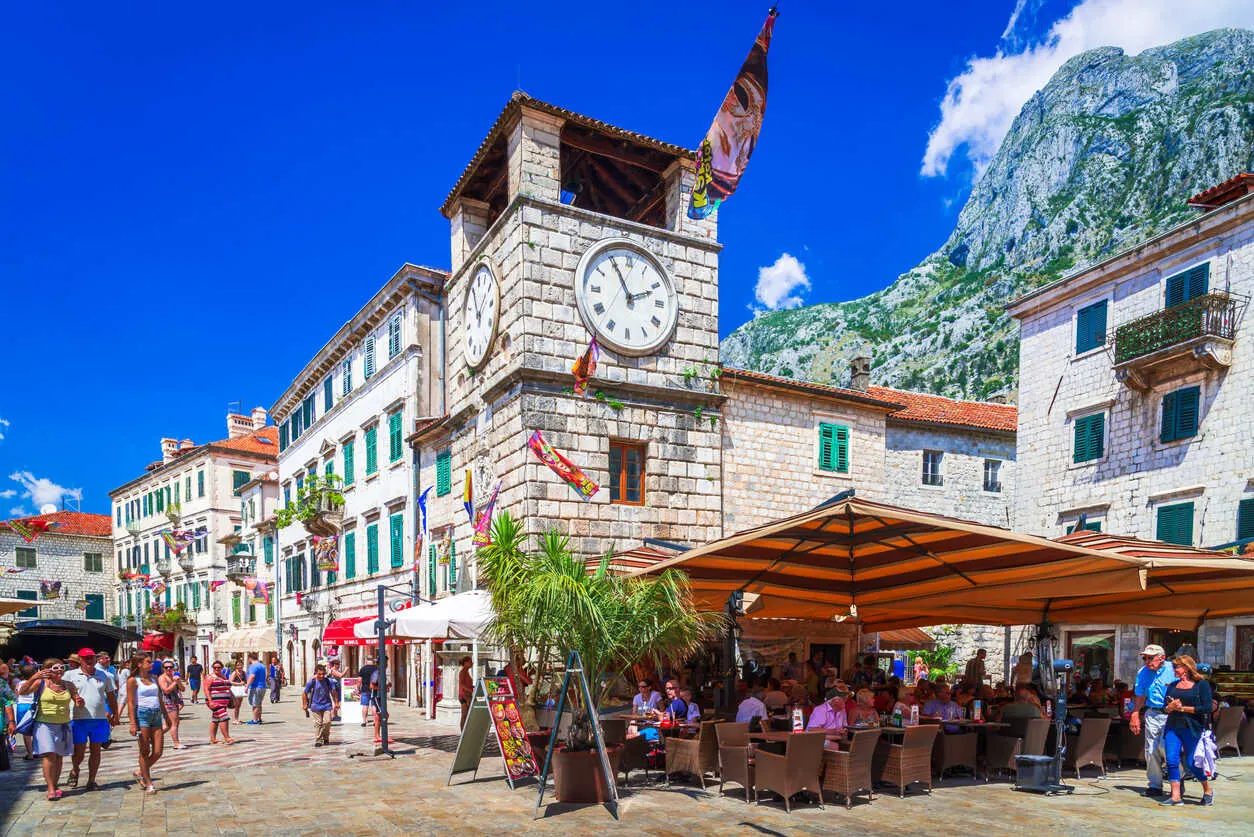
Tip: Visit Montenegro in mid-September, when the bay is still warm… but free of tourists.|©iStock/emicristea
Outside of the tourist places, Montenegro is an extremely affordable place to live.
Food: Restaurant meals and supermarket shopping won’t dent your pocketbook very much. A coffee and breakfast pastry at a typical bakery, or pekara, will cost $2 or $3 at most, often less.
Dinner at a very nice bayside restaurant in Tivat (grilled chicken in a porcini mushroom sauce with vegetables and aromatic potatoes, plus a glass of wine) is less than $25—and tipping isn’t really required in Montenegro.
At a more traditional Balkan-style restaurant popular among locals, an order of beef or chicken kebabs, a Greek salad, and a beer will cost less than $10.
As I always do wherever I am out in the world, I popped into a local supermarket—Voli—to gauge prices.
A dozen eggs were about $2.25. A liter of milk, about $0.92, the equivalent of about $5 per gallon. A pound of apples is about $2. A pound of tomatoes is slightly less. A pound of onions is $1.75, while the same weight of potatoes is $1.30. A 12-ounce bottle of Heinz ketchup is $1, and a 16-ounce carton of tomato sauce is $0.85. A loaf of bread is about $1 as well. And a pound of ground beef is $2.50, while a whole chicken is about $1.10 per pound.
And this is crazy, but two liters of local beer—roughly a six-pack—is under $2.
Utilities: Electricity, phone, cable, water, etc.—they’re all quite cheap.
Electricity runs about $25 to $40 per month, on average, for a typical two-bedroom apartment of roughly 1,000 square feet. You’ll definitely need heating in the winter, as this part of the Adriatic can feel bone-chillingly damp. And the hottest parts of the summer will likely demand A/C for a few weeks.
A cable, internet, and mobile-phone package through M:Tel ranges between $40 and $55, depending on add-ons like HBO and internet speed.
Monthly water and trash bills combined are in the $15 to $20 range.
All in, utilities will run roughly $120 per month, or less.
Rent: This is going to depend entirely on where you live and what you want in an apartment.
In Podgorica, a fairly bland capital that still smacks of its Soviet era, a small two-bedroom, one-bath apartment in the city center costs between $650 and $800 per month.
In Tivat, similar properties start at about $800 and go up to $2,000, depending on size and amenities. A nearby one-bedroom, 1,300-square-foot penthouse with views for days and a great deck is $1,950.
Seven minutes north of Kotor, in the little town of Dobrota, an 800-square-foot, two-bedroom, one-bath apartment with postcard views from every room and a balcony big enough to fit a table for four is just under $1,300 monthly. A one-bedroom with a separate office space and similarly picturesque views is $865.
If you’re dead-set on living in Old Town Kotor proper, you can find a one-bed/one-bath in an old stone building, its windows facing the main square, for $1,400. Just know what you’re getting into with the crowds and noise during high season.
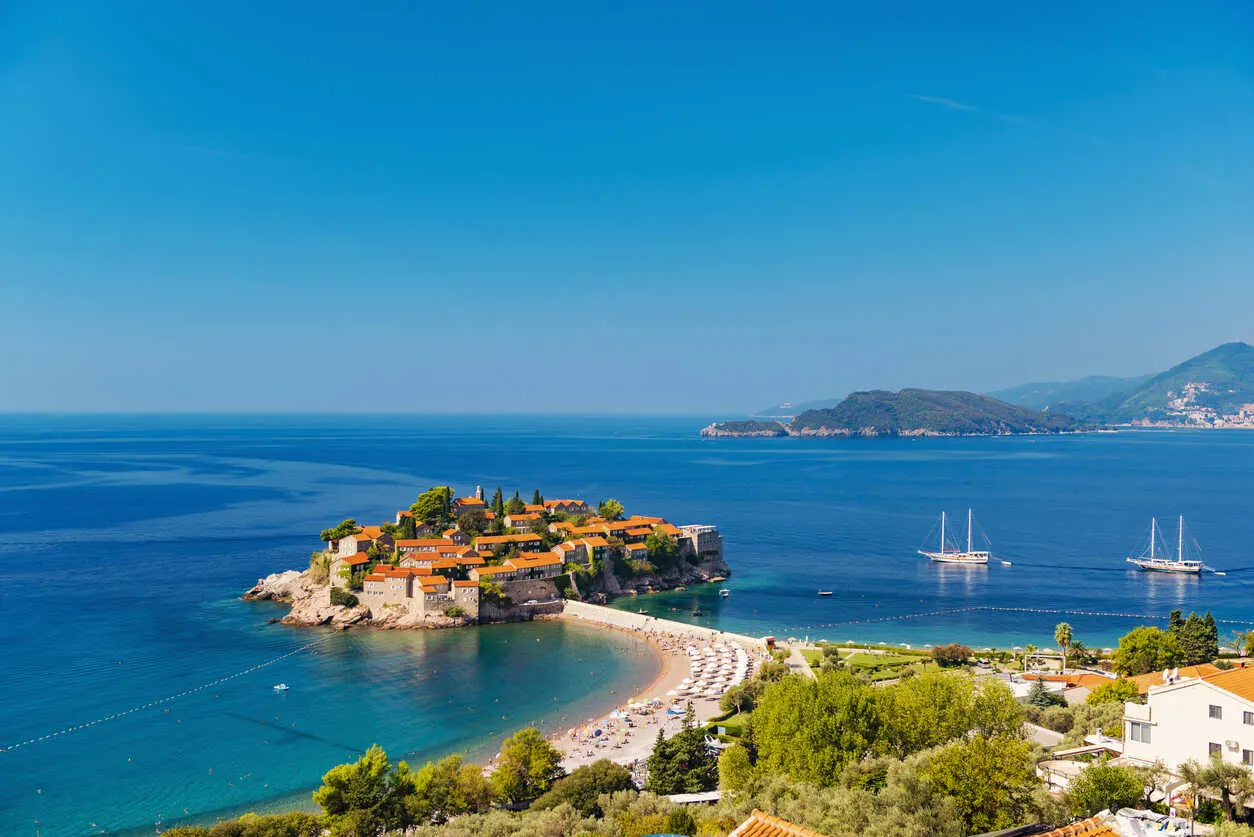
Key tips for visiting Montenegro, from airports to accommodations.|©iStock/Rocky89
Getting There: Two international airports serve Montenegro: in Podgorica, the capital city, a roughly 90-minute drive to Kotor Bay, and Tivat, a smaller town in Kotor Bay. (Nothing fancy about the names here—they’re simply called Podgorica Airport and Tivat Airport, respectively. Makes it easy to remember.) Both have a fairly limited number of flights per day. Podgorica is best reached from the US on Turkish Airlines stopping in Istanbul, or Austrian Airlines through Vienna. Montenegro Air offers direct service from Frankfurt, Germany.
Tivat is more convenient but offers fewer flights. Again, Turkish Airlines through Istanbul is an option. From London, Jet2 flies to Tivat from Stansted Airport, while easyJet serves the city from London Gatwick.
Getting Around: You can rely on taxis to go between towns, since they’re all relatively close. Uber is not allowed in Montenegro. The best option is to rent a car at either airport, since driving in Kotor Bay is part of the joy of this trip. Numerous rental car agencies serve the region, including Sixt, Hertz, Europcar and others.
Where To Stay: This depends on what you seek. A quiet/hip resort for couples, away from everything and offering fabulous views is Nikki Beach Montenegro, across the bay from Tivat. There’s little around except local homes. Rates can be pricey—between €325 and €600 in-season, but as low as €150 in the spring, before the season begins.
If you want to stay within Kotor’s Old Town walls, Boutique Hotel Astoria is lovely and will run you about €144 per night in the off-season, and double that in the summer. Just be aware that in-season, Old Town can be especially loud and crowded, even at night, as tour buses and cruise ships drop off hundreds of passengers daily.
Just outside the Old Town gates is the Hyatt Regency Kotor Bay Resort, right on the bay, much quieter, and an easy walk to Old Town. Off-season rates can be as low as €135, while summer rates are €250 to €340.
In Tivat, the Hotel Palma is quite nice and set on a private beach. A very South of France vibe. Note that beaches in Kotor Bay are pebbly rather than sugary sand. Rooms are just €95 per night in-season, and €50 off-season. Old Town Kotor is about a 25-minute drive without traffic. In traffic, it’s closer to 45 minutes. Or take the bayside road around the peninsula. It’s the same 45 minutes, but magnitudes prettier.
Note that lots of hotels close in October or November, and don’t reopen until spring.
Money Matters: Montenegro operates in euros, and just about everywhere accepts credit cards. ATMs are widely available. Just avoid the Euronet ATMs (high fees!) or any not affiliated with a bank. Look for signs for Adriatic Bank, CKB, and NLB. And always decline the currency conversion, if asked.
Visa Needs: Americans can enter Montenegro and stay for up to 90 days on a US passport.
Sign up for our free daily IL Postcards e-letter and we’ll immediately send you a free report on the WORLD’S #1 RETIREMENT HAVEN—plus 9 more of the most desirable and very affordable destinations where you can upgrade your retirement right now. Each day you’ll learn about the best places to retire, travel, buy real estate and enjoy life overseas.
By submitting your email address, you will receive a free subscription to IL Postcards and special offers from International Living and our affiliates. You can unsubscribe at any time, and we encourage you to read more about our Privacy Policy.
Buy a Property and Stay Year-Round in This European Gem
The easiest way to get a residency permit in Montenegro is by buying a residential property.
There’s no minimum value on the property, but it must be habitable. The permit is valid for a year and can be renewed if you continue to own the property. There is no specific income requirement, but you need to have at least €3,650 ($3,962) in a Montenegrin bank account. The one catch is that you can’t spend more than 90 days outside Montenegro during any 12-month period.
There’s another oddball route to a temporary residency permit. Montenegro is a popular location for yachting. Owners and crew of boats with a marina booking of longer than 90 days can get temporary residency in the country as long as the boat is located there. Unlike the residential property option, this allows you to be out of Montenegro for more than 90 days a year without penalty.
After five years in Montenegro as a temporary resident, you can apply for “permanent” residency. It’s not actually permanent, since it lasts for five years and must be renewed regularly. —Ted Baumann
Stop overcomplicating, second-guessing, or giving in to “information paralysis” … Let’s sit down together (online), and I’ll help you create a custom blueprint for your international goals… second passports, tax, travel, retirement, estate, business, and more…



